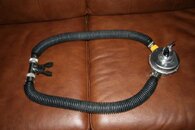A DH is going to freeflow at the surface if you get into the right position due to it's design, the single major flaw in it's design IMO but there is little you can do to prevent it- design wise. Add to that, all the upgrades that have been made and many of us tuning the regs to fairly high performance levels, freeflows become more of an issue. Proper technique reduces them a lot but having them prevented without having to be so vigilant would be nice. The plug does a good job but it's not as elegant of a solution as we would like so the next logical step is designing a mouthpiece that does the job of the plug but with a lot more elegance.
By the way, the tool also works on the Argonuat.
We should point out for those who are not familiar with a double hose, that this only happens when you take the mouthpiece out of your mouth and the mouthpiece is higher than the diaphragm. It is the same effect as when you take a well tuned single hose regulator out of your mouth with the mouthpiece pointing up.
It is all about the differential water pressure due to the water column. The same physics applies to all regulator, the only difference is that the distance from the diaphragm to the open mouthpiece can be much higher with a DH.
---------- Post added April 9th, 2014 at 08:01 PM ----------
The design for a closing DSV (Dive Surface Valve) style of mouthpiece with the ability of using a replaceable byte (single hose type mouthpiece) is in the works. It is just going to get a bit more time.
I have already designed and build a couple of different DSV type of mouthpieces, but I have a new design that reuses the same valve cages that we already have available.
The design is fairly simple, but I have to do a precise 3D model that we can have printed in a 3D printer.
This all takes time. I do all these designs just as a hobby.
Note: I actually don't build anything. Herman builds a lot of the prototype parts based on my drawings, but some of the more complicated parts Bryan (from VDH) has have a commercial machine shop make it. Bryan also has the molds made for the molded parts (he owns the molds).
---------- Post added April 9th, 2014 at 08:11 PM ----------
With regard to mouthpieces (I'm sure its been asked before), but why not reproduce the Hope-Page mouthpiece or some variant? I believe that it will take a modern replacement mouthpiece. And if not that, why not cast something like it in a hard plastic or bakelite into which wagon wheels would fit or on which you could mount a modern mouthpiece? Will all the fabricating that Luis and Bryan seem to be doing, I would think that a HP mouthpiece wouldn't be too difficult. Of course, I've never tried or priced such a thing and it may be just too expensive.
There has been some talk about making a Hope Page reproduction mouthpiece. I was asked if I would do the drawings. I agree, but then I pointed out that a true reproduction required at least three molded parts and the machined ring, the project went nowhere.
The three molded parts are: the main boy, the two hose connection (left and right are the same), and the valve wagon wheel cages (I think they are the same or I could make them the same mold).
That is three molds. Good quality production molds are expensive.
By reusing the existing mouthpiece valve wagon wheels, it would save some money.
Last edited:




